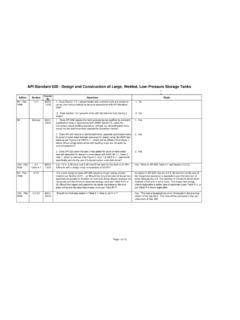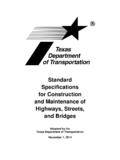Transcription of Advisory of Transportation Circular - faa.gov
1 Department Advisory of Transportation Federal Aviation Administration Circular Subject: Standard Specifications for Date: 12/21/2018 AC No: 150/5370-10H. construction of Airports Initiated By: AAS-100 Change: 1 Purpose. The standard specifications contained in this Advisory Circular (AC) relate to materials and methods used for construction on airports. Items covered in this AC include general provisions, earthwork, flexible base courses, rigid base courses, flexible surface courses, rigid pavement, fencing, drainage, turf, and lighting installation. 2 Cancellation. This AC cancels AC 150/5370-10G, standards for Specifying construction of Airports, dated July 21, 2014. 3 Application. The Federal Aviation Administration (FAA) recommends the guidelines and specifications in this AC for materials and methods used in airfield development for construction and rehabilitation projects on airports. This AC does not constitute a regulation and is not mandatory, however the following applies: a.
2 The standard specifications contained in this AC are practices that the FAA recommends for the construction of pavements and airport development serving aircraft greater than 30,000. pounds (13,600 kg). b. This AC contains methods and procedures for compliance with 14 CFR part 139 that are acceptable to the Administrator. c. The use of this AC is mandatory for all projects funded under Federal grant assistance programs, including the Airport Improvement Program (AIP). See Grant Assurance No. 34., Policies, standards , and Specifications. d. This AC is mandatory, as required by regulation, for projects funded with the Passenger Facility Charge program. See PFC Assurance #9, standards and Specifications. e. For building construction , the General Contract Provisions are applicable, in addition applicable laws and local building codes shall serve as construction standards acceptable to the FAA. 12/21/2018 AC 150/5370-10H. 4 Developing Project Specifications.
3 The standard specifications in this AC must be edited to develop construction specifications for individual federally funded projects. a. For individual projects, pertinent portions of the standards must be copied into the contract documents. b. For airfield pavement projects at non-primary airports, serving aircraft less than 60,000. pounds (27216 kg), state highway specifications may be used in states where the state has requested and received FAA approval to use state highway specifications. c. Modifications to standards requests contained in this AC must meet the requirements of FAA Order , Modifications to Agency Airport Design, construction , and Equipment standards . d. When preparing construction contracts for AIP or PFC projects or for grant obligated airports, use current contract provisions and mandatory provisions (wage, labor, Disadvantaged Business Enterprise, etc). e. Disadvantaged Business Enterprises (DBE), Equal Employment Opportunity (EEO), etc.
4 Can be found at the FAA website: f. Additional contract clauses may be required to comply with local and state laws relating to advertising, awarding, and administrating construction contracts. 5 Changes, Additions and Deletions to the FAA Standard Specifications. a. Engineer Notes (shown between lines of asterisks) contained in the AC provide directions to the Engineer. These notes explain the options available to the Engineer when preparing project documents, and the appropriate changes and additions that must be made. The final project documents must not include the Engineer Notes. b. Where numbers, words, phrases or sentences are enclosed in brackets [ ], a choice or modification must be made. Where blank spaces [ ] occur in sentences, the appropriate data must be inserted. c. Where entire paragraphs are not applicable, the text should be deleted and Not Used . entered after the paragraph number, do not renumber specification paragraphs. A.
5 Modification of standards (MOS) in accordance with FAA Order is required for any deviation from standard specifications applicable to material and construction methods required to accommodate an unusual local condition on a specific project. Note that adding a new section and/or item requires a MOS. 6 Principal Changes. This AC contains the following principal changes: 1. Extensive technical and editorial edits have been made throughout the document based on comments received during the review periods. 2. Updated references to the ACs and industry standards including ASTM International (formerly known as the American Society for Testing and Materials (ASTM)), American Association of State Highway and Transportation Officials (AASHTO), Asphalt Institute (AI), etc. 3. Added guidance in Engineer Notes on use of individual specifications. ii 12/21/2018 AC 150/5370-10H. 4. Section 10: Added definitions for Apron, Certificate of Analysis (COA), Certificate of Compliance (COC), Control Strip, Modification of standards (MOS); Quality Assurance (QA), Quality Control (QC), Quality Assurance (QA) Laboratory, Resident Project Representative (RPR); Runway Safety Area (RSA), Safety Plan Compliance Document (SPCD), Taxilane, and Taxiway/Taxilane Safety Area (TSA).
6 Revised definitions for Change Order, Contract, Force Account, Contractor's laboratory to Contractor's Quality Control Facilities; Laboratory to Quality Assurance (QA) Laboratory; Inspector to Quality Assurance (QA) Inspector, Pavement to Pavement Structure; and Supplemental Agreement. Added Owner Defined Terms to allow addition of any project specific terms that may be needed. 5. Section 50: Removed outdated guidance on construction layout and stakes. 6. Section 60: Revised guidance for RPR's field office. 7. Section 70: Revised 70-05 Federal Participation; Revised 70-06 Sanitary, health, and safety provisions; Retitled and revised 70-08 as construction Safety and Phasing Plan (CSPP).. 8. Moved Section 100 Contractor Quality Control Program (CQCP) out of the General Provisions and re-number as Item C-100. Clarified requirements of the CQCP; added elements that must be addressed for pavement projects; added requirements for Contractor QC testing facilities for pavement projects (P-401, P-403, P-501, and P-404; and added C- 100-13 Basis of measurement and payment paragraph to allow for lump sum payment of CQCP with schedule of partial payments during contract.)
7 9. Moved Section 105 Mobilization out of the General Provisions and re-numbered as Item C-105.. 10. Moved Section 110 Method of Estimating Percentage of Materials Within Specification Limits (PWL) out of the General Provisions. Renumbered as Item C-110. Allows the Engineer to delete Item C-110 when P-401, P-501 and/or P-404 are not in a project. 11. Re-titled Item P-101 Surface Preparation to Item P-101 Preparation/Removal of Existing Pavements to better reflect purpose of specification. 12. Item P-156, Temporary Air and Water Pollution, Soil Erosion, and Siltation Control has been renumber as Item C-102, Temporary Air and Water Pollution, Soil Erosion, and Siltation Control.. 13. Add new Item P-156, Cement Treated Subgrade. Added a new specification for cement treated subgrade. 14. Item P-157 [ Cement ][ Lime ] Kiln Dust Treated Subgrade Added Lime Kiln Dust. This specification now allows either Lime Kiln Dust or Cement Kiln Dust. 15. Numerous changes within the base course specifications (P-208, P-209, P-210, P-211, P- 212, P-217, and P-219) including standardizing format for materials, construction , and materials; placing material properties in table format; and adding guidance for separation fabric.
8 Added requirement for control strip to demonstrate materials, means and methods prior to full production. 16. Added new P-207 In-place Full Depth Reclamation (FDR) Recycled Asphalt Aggregate Base Course. 17. Item P-301 Soil-Cement Treated Soil-Aggregate Subbase Course has been renumbered and renamed as Item P-220 Cement Treated Soil Base Course and moved under Part 4 Base Courses. iii 12/21/2018 AC 150/5370-10H. 18. Added new P-307 Cement treated Permeable Base Course (CTPB). 19. Revised and simplified definition of Lot size and Partial lot in P-401, P-403, P-501, and P-404. 20. Swapped Contractor Quality Control (CQC) and Material Acceptance paragraphs in P- 401, P-403, P-501 and P-404 so the material acceptance and measurement/payment paragraphs are together and quality control prior to measurement paragraphs. 21. P-401: Placed material properties in table format; clarified JMF submittal requirements;. removed paragraph on testing facilities and placed guidance in Section C-100, Contractor Quality Control Program (CQCP); added paragraph identifying smoothness equipment requirements; added paragraph Smoothness for Contractor Quality Control; added paragraph Profilograph smoothness for QA Acceptance clarifying that final profilograph is on the full length of the project; added use of the Asphalt Pavement Analyzer (APA) to Item P-401 eliminating the need to run stability and flow when using the Marshall Method and allowing the same asphalt design criteria in Table 1 to apply regardless of which mix design method is selected, Marshall or Gyratory.
9 22. P-403: Clarified use of state highway specifications in initial Engineer's Note; similar changes made throughout P-403 to those in P-401. 23. P-501: Clarified reactivity testing requirements; placed material properties in table format;. clarified combined aggregate gradation paragraphs and Contractor requirements; added requirement for Control Strip. Added pay adjustment for repairs and grinding. 24. Renumbered P-601 as P-404 Fuel-Resistant Asphalt Mix Pavement. 25. P-404: Added Engineer Note on when to use P-404 to replace top 2 inches of P-401; placed material properties in table format; added requirement for contactor submission of manufacturer's Certificate of Analysis (COA) for the asphalt binder; clarified JMF. submission requirements. 26. Added new P-608-R RapidCure Seal Coat. 27. P-609: Retitled as Chip Seal Coat; placed material properties in table format; added requirement for Contractor to provide a copy of the manufacturer's Certificate of Analysis (COA) for the asphalt material.
10 28. P-610: Retitled as Concrete for Miscellaneous Structures. 29. P-620: Added table to specify marking materials by type, color, and bead type. Added acceptance tests for retro-reflectivity. 30. Added new P-623 Emulsified Asphalt Spray Seal Coat. 31. F-163 and F-164: Removed example fence skirt and fence details. 32. Added new L-125 Installation of Airport Lighting Systems. 33. D specs: Added requirement for precast concrete structures to be furnished by a plant meeting National Precast Concrete Association Plant Certification Program or another RPR. approved third party certification program. 34. T specs: Added note at beginning of each T spec on wildlife hazard attractants and mitigation and appropriate selection of turf materials. 35. L specs: Added statement to concrete paragraphs specifying use of P-610 stating that If fly ash meeting the requirements of P-610 is added to the concrete, at a rate of 30% of iv 12/21/2018 AC 150/5370-10H. cementitious material, or 55% slag cement, no reactivity testing of the aggregates shall be required.













